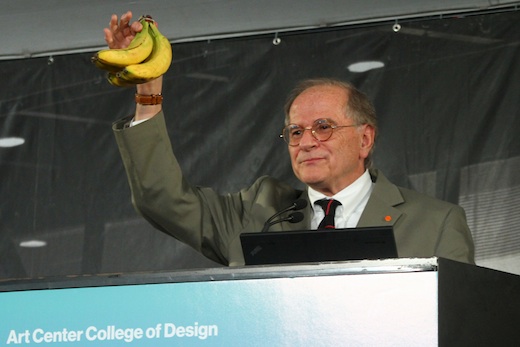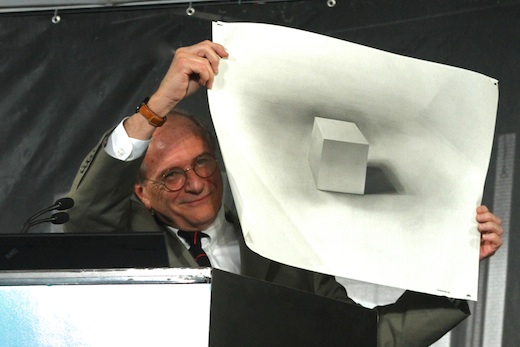
Industrial Design alumnus Gordon Bruce (BS 72) goes bananas at Art Center’s Spring 2014 graduation. Photo: John Dlugolecki
“Maintain truth to your core and you will be beautiful and create beautiful things in your future,” Industrial Design alumnus Gordon Bruce (BS 72) told graduating students during Art Center’s Spring 2014 Graduation Ceremony on Sat., April 19, where he received a Lifetime Achievement Alumni Award.
Saying that the award meant “more to me than you’ll ever know,” Bruce delivered a lively speech in which he recounted: another college’s admissions counselor telling his dad that his son “didn’t have the right stuff” to design; sharpening pencils as a part-time office boy at the studio of architect and designer Eliot Noyes; meeting the “gods of design” through the College’s lecture series, including Charles Eames, Paolo Soleri and Niels Diffrient, the latter with whom he became best friends.
Bruce completely won the audience over when he brought out some props for “show and tell.” From behind the podium he pulled out the first drawing he ever created at Art Center, which he made for a class taught by legendary instructor Ted Youngkin. He told the students that he had turned down a tantalizing late night invitation from a beautiful woman in order to complete that drawing for Youngkin’s class. ”The next morning I said, ‘Mr. Youngkin, do you realize what I sacrificed for you?’,” Bruce said with a laugh. “But [he] had this capability of making you want to do something for him.”

Industrial Design alumnus Gordon Bruce (BS 72) holds up the very first drawing he made for Art Center. Photo: John Dlugolecki
Later, Bruce brought out a bunch of bananas and told a story about teaching at Samsung’s Innovation Design Lab and asking his students to spend ₩5,000 on a product, bring it to class and tell him why it’s a beautiful object. Bruce said they brought back “the worst stuff, terrible, all kitschy,” and then showed the class what be bought for the same amount of money: a bunch of bananas. Bruce continued:
They said, ‘Bananas? What do bananas have to do with design?’ Mother Nature is the best designer. It comes in a bunch. You can buy as many as you want. It’s customizable. It’s convenient. [Places a banana in his pocket] It fits in your pocket. It’s intuitive: I know you don’t eat a banana this way. [Pretending to eat the banana like corn on the cob] Sanitation, [pointing to the peel] it protects the inside. Biodegradable. Potassium. [taking a bite] Delicious. [chewing the banana] Easily manufactured. It’s the biggest market in the world: everybody loves bananas! So I told my my fellow designers, ‘Imagine if you could design a product that uses these same principles.’ … So they said, ‘You mean, we should design a cell phone that looks like a banana?’ [sighs] So I realized I had a long way to go.
After which Bruce received a loud round of applause.
More on Gordon Bruce:
Throughout his career, Toronto-born author and designer Gordon Bruce has worked with multinational corporations on a wide range of products, including airplanes, computers, furniture and medical products. His work has been shown at the Victoria and Albert Museum, London, and his designs are included in the permanent design collections of The Museum of Modern Art, New York; The Centre Pompidou, Paris; and The National Museum of American History, Washington, D.C.
Bruce’s career began at Eliot Noyes and Associates in New Canaan, Conn., where his clients included IBM, Westinghouse and Mobil. In 1985, he started his own business, Gordon Bruce Design. From 1991 to 1994 he served as Art Center’s Vice President of Asian Relations and from 1995 to 1999 he served as Samsung’s Product Design Chairman for the company’s Innovative Design Lab (IDS). While in Seoul, Bruce and his IDS colleague James Miho, Art Center’s then-Chair of Graphic Design, developed a curriculum to reeducate Samsung’s best designers.
From 2000 to 2003 Bruce designed the furniture for Moshe Safdie Architects’ Salt Lake City Public Library. In 2001 he worked with several IBM research centers to design a virtual/physical campus concept for the Swiss Federal Institute of Technology. In 2003, Bruce helped Porsche Design open their U.S. office and also designed a range of golf products for the company. Between 2002 and 2009, he served as head design consultant for Lenovo’s Innovative Design Center, Beijing; consulting Honorary Chairman of Design for Changhong, China’s largest TV manufacturer; and head design consultant to OSIM, Singapore.
In 2007, Phaidon Press, London published his monograph Eliot Noyes: A Pioneer of Design and Architecture in the Age of American Modernism. He has written articles articles for Design Management Institute Journal, ArchitectureBoston and AXIS.
Presently, Bruce is working with the Bühler Group, Switzerland, and Huawei Technologies in Shenzhen and Shanghai. He lectures annually at Harvard’s Graduate School of Design. For the past seven years, he has served as a jury member of the Red Dot Design Awards. He has also started writing a book on Samsung’s Innovative Design Lab.








